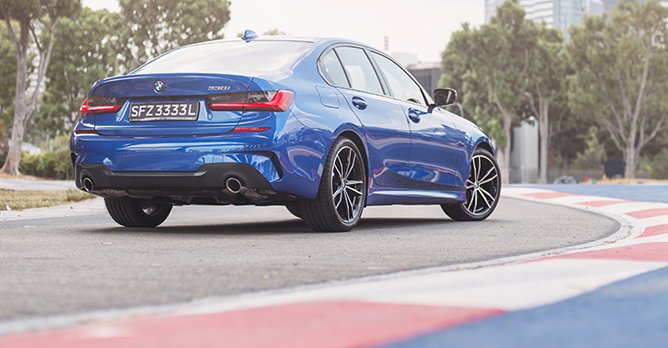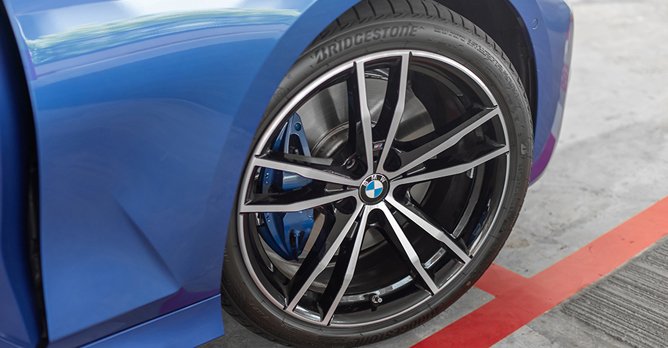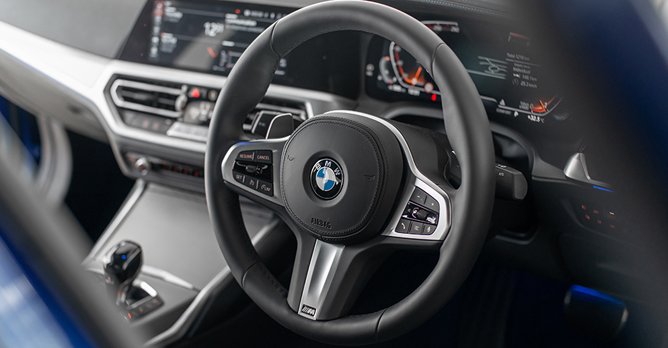BMW 3 Series Sedan 330i M Sport (A) Review
23 Mar 2019|33,576 views
What We Like
Smooth engine with very linear power delivery
Entire car feels more premium than before
More spacious and practical
Handling and driving feel is top-notch
What We Dislike
Ride may be a little firm for some, especially in the rear
When I last reviewed the BMW 3 Series a couple of years ago, I deduced that it was pretty much all the car anyone ever needed, and the poster boy of the compact executive sedan segment.
So when BMW introduced the new seventh generation version of the 3er, which is now bigger, has a more premium-looking interior and loaded with technology, I had several concerns.
Would it look too much like the 5 Series? Would its increase in size mean more weight and hence less agility? And would it be too expensive? With its key in hand, I finally got the chance to find out.
Boy, have you grown!
My test car for the day, a 330i M Sport in beautiful Portimao Blue, was parked next to a 5er at time of collection. And side-by-side, it was clear than the 3er has grown by quite a bit.
It is now 76mm longer, with a 41mm longer wheelbase, 1mm taller, and 16mm wider than its predecessor.
But more importantly, its stretched proportions mean that rear passengers now get 11mm more legroom, while headroom, as well as shoulder room have been increased all around.
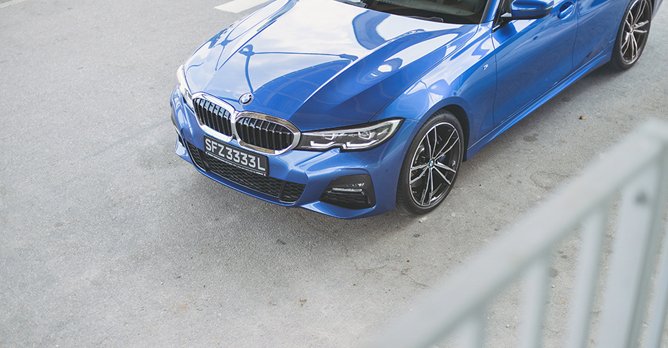
 Like the rest of BMW's new models, the 3er's kidney grille has been upsized but it matches the car's increased dimensions well
Like the rest of BMW's new models, the 3er's kidney grille has been upsized but it matches the car's increased dimensions well
Its boot space remains the same at 480 litres, but the car's increased dimensions allow the boot to be reconfigured to offer more usable space in the primary loading compartment.
Furthermore, 36 litres of storage space have been arranged throughout the cabin; there is enough space for massive smartphones, tablets in the doors, and enough USB ports.
The added practicality also comes a wealth of improvements to design of the interior, such as a new fully-digital 12.3-inch instrument cluster and 10.25-inch infotainment touchscreen display - both of which are fully customisable in more ways than you'd bother to, and the graphics look smart, yet jazzier than I'm used to for a Bimmer.
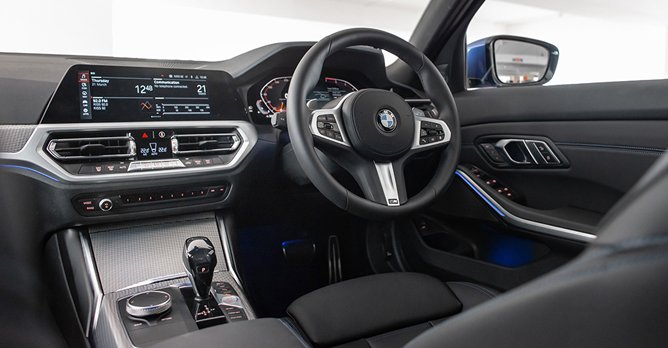
 Cabin of the new 3er is cleaner designed than before and offers better materials along with new digital displays
Cabin of the new 3er is cleaner designed than before and offers better materials along with new digital displays
The BMW Intelligent Personal Assistant, which I tested in the new X5 is also on board and works in conjunction with the aforementioned displays as part of BMW's new operating system.
It is a digital, voice-activated butler that helps operate and explain various functions of the car such as the GPS, as well as locate the nearest petrol stations or cafes.
But because I'm a bit of a Luddite, I was more impressed by the new dashboard, which follows the design language of the X5, 8 Series and Z4.
It looks a lot cleaner than before, and feels a whole lot more expensive as well, thanks to things like a more slender instrument panel and the new Vernasca leather upholstery.
So far, it's great news all around but does it still drive like a 3er?
Despite having done a bit of growing up, the new 3er is actually 55kg lighter than the car it replaces. By using materials such as high-strength steel, the body of the car has lost 20kg, while its aluminium bonnet helped shaved another 15kg off.
So when BMW introduced the new seventh generation version of the 3er, which is now bigger, has a more premium-looking interior and loaded with technology, I had several concerns.
Would it look too much like the 5 Series? Would its increase in size mean more weight and hence less agility? And would it be too expensive? With its key in hand, I finally got the chance to find out.
Boy, have you grown!
My test car for the day, a 330i M Sport in beautiful Portimao Blue, was parked next to a 5er at time of collection. And side-by-side, it was clear than the 3er has grown by quite a bit.
It is now 76mm longer, with a 41mm longer wheelbase, 1mm taller, and 16mm wider than its predecessor.
But more importantly, its stretched proportions mean that rear passengers now get 11mm more legroom, while headroom, as well as shoulder room have been increased all around.

Its boot space remains the same at 480 litres, but the car's increased dimensions allow the boot to be reconfigured to offer more usable space in the primary loading compartment.
Furthermore, 36 litres of storage space have been arranged throughout the cabin; there is enough space for massive smartphones, tablets in the doors, and enough USB ports.
The added practicality also comes a wealth of improvements to design of the interior, such as a new fully-digital 12.3-inch instrument cluster and 10.25-inch infotainment touchscreen display - both of which are fully customisable in more ways than you'd bother to, and the graphics look smart, yet jazzier than I'm used to for a Bimmer.

The BMW Intelligent Personal Assistant, which I tested in the new X5 is also on board and works in conjunction with the aforementioned displays as part of BMW's new operating system.
It is a digital, voice-activated butler that helps operate and explain various functions of the car such as the GPS, as well as locate the nearest petrol stations or cafes.
But because I'm a bit of a Luddite, I was more impressed by the new dashboard, which follows the design language of the X5, 8 Series and Z4.
It looks a lot cleaner than before, and feels a whole lot more expensive as well, thanks to things like a more slender instrument panel and the new Vernasca leather upholstery.
So far, it's great news all around but does it still drive like a 3er?
Despite having done a bit of growing up, the new 3er is actually 55kg lighter than the car it replaces. By using materials such as high-strength steel, the body of the car has lost 20kg, while its aluminium bonnet helped shaved another 15kg off.
Elsewhere, things like new subframes and struts round off the diet.
BMW also says that a meticulous amount of attention has been paid to the balance of the car, while an increased track width and enhanced body stiffness guarantee that sheer driving pleasure.
These improvements are apparent with just 10 minutes of being on the road. Our M Sport tester had lowered suspension (by 10mm), equipped with a lift-related damper system that behaves like an adaptive damper but is fully hydraulic.
Married to its stiffened chassis, the ride is firm enough to make your mother complain and the car feels impressively tight but personally, I never found it jarring - at least from the driver's seat.
In fact, I loved that it feels that way, like it rides on a set of very expensive coilovers. Body control is excellent and it turns with a keenness that brings to life that all-familiar BMW dynamism.
Its variable steering, which loads up nicely and is not unnaturally quick, and its exceptional front-end grip, helps immensely with that.
There is an enthusiasm and confidence about the way it moves that is rarely displayed by its equivalent rivals, so much so that you can immediately hop in, feel comfortable and get excited about driving it.
In its class, only the Alfa Romeo Giulia offers this much satisfaction behind the wheel. The linearity in which the 3er delivers its 254bhp and 400Nm of torque, and the flawlessness of its transmission shifts, too, set the standards of its class.
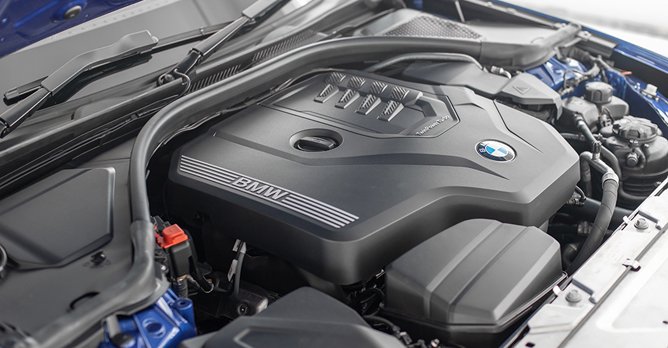
 254bhp and 400Nm of torque from its turbocharged 2.0-litre help it go from 0-100km/h in just 5.8 seconds
254bhp and 400Nm of torque from its turbocharged 2.0-litre help it go from 0-100km/h in just 5.8 seconds
Considering it's so much better, it must cost a lot more?
Thankfully no. The last 330i to grace our shores went for just under $230,000 and this one, at time of publishing, is priced at $231,999. Not to mention, its equivalently powered Audi and Mercedes rivals will cost more.
With the new 3er, BMW seem to have thrown everything but the kitchen sink at it to ensure it continues the legacy of its forebearers, and that it remains the poster boy of the compact executive sedan segment.
It can thus be summed up that while some cars are built for people who enjoy driving, and others made for those who enjoy life, the 3 Series has once again managed to cater to both types, and then some.
It may not be as fast as the 330i we tested here, but if you're interested in the 3 Series, why not also get a better look at the car's interior in our video review?
BMW also says that a meticulous amount of attention has been paid to the balance of the car, while an increased track width and enhanced body stiffness guarantee that sheer driving pleasure.
These improvements are apparent with just 10 minutes of being on the road. Our M Sport tester had lowered suspension (by 10mm), equipped with a lift-related damper system that behaves like an adaptive damper but is fully hydraulic.
Married to its stiffened chassis, the ride is firm enough to make your mother complain and the car feels impressively tight but personally, I never found it jarring - at least from the driver's seat.
In fact, I loved that it feels that way, like it rides on a set of very expensive coilovers. Body control is excellent and it turns with a keenness that brings to life that all-familiar BMW dynamism.
Its variable steering, which loads up nicely and is not unnaturally quick, and its exceptional front-end grip, helps immensely with that.
There is an enthusiasm and confidence about the way it moves that is rarely displayed by its equivalent rivals, so much so that you can immediately hop in, feel comfortable and get excited about driving it.
In its class, only the Alfa Romeo Giulia offers this much satisfaction behind the wheel. The linearity in which the 3er delivers its 254bhp and 400Nm of torque, and the flawlessness of its transmission shifts, too, set the standards of its class.

Considering it's so much better, it must cost a lot more?
Thankfully no. The last 330i to grace our shores went for just under $230,000 and this one, at time of publishing, is priced at $231,999. Not to mention, its equivalently powered Audi and Mercedes rivals will cost more.
With the new 3er, BMW seem to have thrown everything but the kitchen sink at it to ensure it continues the legacy of its forebearers, and that it remains the poster boy of the compact executive sedan segment.
It can thus be summed up that while some cars are built for people who enjoy driving, and others made for those who enjoy life, the 3 Series has once again managed to cater to both types, and then some.
It may not be as fast as the 330i we tested here, but if you're interested in the 3 Series, why not also get a better look at the car's interior in our video review?
What We Like
Smooth engine with very linear power delivery
Entire car feels more premium than before
More spacious and practical
Handling and driving feel is top-notch
What We Dislike
Ride may be a little firm for some, especially in the rear
When I last reviewed the BMW 3 Series a couple of years ago, I deduced that it was pretty much all the car anyone ever needed, and the poster boy of the compact executive sedan segment.
So when BMW introduced the new seventh generation version of the 3er, which is now bigger, has a more premium-looking interior and loaded with technology, I had several concerns.
Would it look too much like the 5 Series? Would its increase in size mean more weight and hence less agility? And would it be too expensive? With its key in hand, I finally got the chance to find out.
Boy, have you grown!
My test car for the day, a 330i M Sport in beautiful Portimao Blue, was parked next to a 5er at time of collection. And side-by-side, it was clear than the 3er has grown by quite a bit.
It is now 76mm longer, with a 41mm longer wheelbase, 1mm taller, and 16mm wider than its predecessor.
But more importantly, its stretched proportions mean that rear passengers now get 11mm more legroom, while headroom, as well as shoulder room have been increased all around.

 Like the rest of BMW's new models, the 3er's kidney grille has been upsized but it matches the car's increased dimensions wellIts boot space remains the same at 480 litres, but the car's increased dimensions allow the boot to be reconfigured to offer more usable space in the primary loading compartment.
Like the rest of BMW's new models, the 3er's kidney grille has been upsized but it matches the car's increased dimensions wellIts boot space remains the same at 480 litres, but the car's increased dimensions allow the boot to be reconfigured to offer more usable space in the primary loading compartment.
Furthermore, 36 litres of storage space have been arranged throughout the cabin; there is enough space for massive smartphones, tablets in the doors, and enough USB ports.
The added practicality also comes a wealth of improvements to design of the interior, such as a new fully-digital 12.3-inch instrument cluster and 10.25-inch infotainment touchscreen display - both of which are fully customisable in more ways than you'd bother to, and the graphics look smart, yet jazzier than I'm used to for a Bimmer.

 Cabin of the new 3er is cleaner designed than before and offers better materials along with new digital displaysThe BMW Intelligent Personal Assistant, which I tested in the new X5 is also on board and works in conjunction with the aforementioned displays as part of BMW's new operating system.
Cabin of the new 3er is cleaner designed than before and offers better materials along with new digital displaysThe BMW Intelligent Personal Assistant, which I tested in the new X5 is also on board and works in conjunction with the aforementioned displays as part of BMW's new operating system.
It is a digital, voice-activated butler that helps operate and explain various functions of the car such as the GPS, as well as locate the nearest petrol stations or cafes.
But because I'm a bit of a Luddite, I was more impressed by the new dashboard, which follows the design language of the X5, 8 Series and Z4.
It looks a lot cleaner than before, and feels a whole lot more expensive as well, thanks to things like a more slender instrument panel and the new Vernasca leather upholstery.
So far, it's great news all around but does it still drive like a 3er?
Despite having done a bit of growing up, the new 3er is actually 55kg lighter than the car it replaces. By using materials such as high-strength steel, the body of the car has lost 20kg, while its aluminium bonnet helped shaved another 15kg off.
So when BMW introduced the new seventh generation version of the 3er, which is now bigger, has a more premium-looking interior and loaded with technology, I had several concerns.
Would it look too much like the 5 Series? Would its increase in size mean more weight and hence less agility? And would it be too expensive? With its key in hand, I finally got the chance to find out.
Boy, have you grown!
My test car for the day, a 330i M Sport in beautiful Portimao Blue, was parked next to a 5er at time of collection. And side-by-side, it was clear than the 3er has grown by quite a bit.
It is now 76mm longer, with a 41mm longer wheelbase, 1mm taller, and 16mm wider than its predecessor.
But more importantly, its stretched proportions mean that rear passengers now get 11mm more legroom, while headroom, as well as shoulder room have been increased all around.

Furthermore, 36 litres of storage space have been arranged throughout the cabin; there is enough space for massive smartphones, tablets in the doors, and enough USB ports.
The added practicality also comes a wealth of improvements to design of the interior, such as a new fully-digital 12.3-inch instrument cluster and 10.25-inch infotainment touchscreen display - both of which are fully customisable in more ways than you'd bother to, and the graphics look smart, yet jazzier than I'm used to for a Bimmer.

It is a digital, voice-activated butler that helps operate and explain various functions of the car such as the GPS, as well as locate the nearest petrol stations or cafes.
But because I'm a bit of a Luddite, I was more impressed by the new dashboard, which follows the design language of the X5, 8 Series and Z4.
It looks a lot cleaner than before, and feels a whole lot more expensive as well, thanks to things like a more slender instrument panel and the new Vernasca leather upholstery.
So far, it's great news all around but does it still drive like a 3er?
Despite having done a bit of growing up, the new 3er is actually 55kg lighter than the car it replaces. By using materials such as high-strength steel, the body of the car has lost 20kg, while its aluminium bonnet helped shaved another 15kg off.
Elsewhere, things like new subframes and struts round off the diet.
BMW also says that a meticulous amount of attention has been paid to the balance of the car, while an increased track width and enhanced body stiffness guarantee that sheer driving pleasure.
These improvements are apparent with just 10 minutes of being on the road. Our M Sport tester had lowered suspension (by 10mm), equipped with a lift-related damper system that behaves like an adaptive damper but is fully hydraulic.
Married to its stiffened chassis, the ride is firm enough to make your mother complain and the car feels impressively tight but personally, I never found it jarring - at least from the driver's seat.
In fact, I loved that it feels that way, like it rides on a set of very expensive coilovers. Body control is excellent and it turns with a keenness that brings to life that all-familiar BMW dynamism.
Its variable steering, which loads up nicely and is not unnaturally quick, and its exceptional front-end grip, helps immensely with that.
There is an enthusiasm and confidence about the way it moves that is rarely displayed by its equivalent rivals, so much so that you can immediately hop in, feel comfortable and get excited about driving it.
In its class, only the Alfa Romeo Giulia offers this much satisfaction behind the wheel. The linearity in which the 3er delivers its 254bhp and 400Nm of torque, and the flawlessness of its transmission shifts, too, set the standards of its class.

 254bhp and 400Nm of torque from its turbocharged 2.0-litre help it go from 0-100km/h in just 5.8 seconds
254bhp and 400Nm of torque from its turbocharged 2.0-litre help it go from 0-100km/h in just 5.8 seconds
Considering it's so much better, it must cost a lot more?
Thankfully no. The last 330i to grace our shores went for just under $230,000 and this one, at time of publishing, is priced at $231,999. Not to mention, its equivalently powered Audi and Mercedes rivals will cost more.
With the new 3er, BMW seem to have thrown everything but the kitchen sink at it to ensure it continues the legacy of its forebearers, and that it remains the poster boy of the compact executive sedan segment.
It can thus be summed up that while some cars are built for people who enjoy driving, and others made for those who enjoy life, the 3 Series has once again managed to cater to both types, and then some.
It may not be as fast as the 330i we tested here, but if you're interested in the 3 Series, why not also get a better look at the car's interior in our video review?
BMW also says that a meticulous amount of attention has been paid to the balance of the car, while an increased track width and enhanced body stiffness guarantee that sheer driving pleasure.
These improvements are apparent with just 10 minutes of being on the road. Our M Sport tester had lowered suspension (by 10mm), equipped with a lift-related damper system that behaves like an adaptive damper but is fully hydraulic.
Married to its stiffened chassis, the ride is firm enough to make your mother complain and the car feels impressively tight but personally, I never found it jarring - at least from the driver's seat.
In fact, I loved that it feels that way, like it rides on a set of very expensive coilovers. Body control is excellent and it turns with a keenness that brings to life that all-familiar BMW dynamism.
Its variable steering, which loads up nicely and is not unnaturally quick, and its exceptional front-end grip, helps immensely with that.
There is an enthusiasm and confidence about the way it moves that is rarely displayed by its equivalent rivals, so much so that you can immediately hop in, feel comfortable and get excited about driving it.
In its class, only the Alfa Romeo Giulia offers this much satisfaction behind the wheel. The linearity in which the 3er delivers its 254bhp and 400Nm of torque, and the flawlessness of its transmission shifts, too, set the standards of its class.

Considering it's so much better, it must cost a lot more?
Thankfully no. The last 330i to grace our shores went for just under $230,000 and this one, at time of publishing, is priced at $231,999. Not to mention, its equivalently powered Audi and Mercedes rivals will cost more.
With the new 3er, BMW seem to have thrown everything but the kitchen sink at it to ensure it continues the legacy of its forebearers, and that it remains the poster boy of the compact executive sedan segment.
It can thus be summed up that while some cars are built for people who enjoy driving, and others made for those who enjoy life, the 3 Series has once again managed to cater to both types, and then some.
It may not be as fast as the 330i we tested here, but if you're interested in the 3 Series, why not also get a better look at the car's interior in our video review?
Also read our comparison article on:
BMW 3 Series 318i vs Mercedes-Benz C-Class C180Car Information
BMW 3 Series Sedan
CAT B|Petrol|15.6km/L
Horsepower
189kW (254 bhp)
Torque
400 Nm
Acceleration
5.8sec (0-100km /hr)
Thank You For Your Subscription.









































